Sexy Trout
Dr. Stewart Owen
You may hear anglers speak of triploid fish, especially at trout fisheries. Triploids are in fact sterile fish, but why do we need them and where do they come from? Read on and fish biologist Dr Stewart Owen will answer these questions and give an insight into a fascinating aspect of fisheries management.
Why do we need sterile fish?
When there is a risk of introducing a new species to a fishery or catchment area, fisheries officers and managers apply the precautionary principle. There must be the 'least risk' of introduced fish affecting those already present. Where a species is non-native such as rainbow trout, fisheries managers do their utmost to prevent a viable population establishing and so reduce the theoretical risk to the natural populations of other species already present. In some cases such as with our native brown trout, the genetic diversity between river systems has recently been realised. Stocking fish of one particular blood-line in a river system containing fish of a different genetic history is now increasingly restricted. To allow some fisheries to function it is necessary to stock with either fish from a particular compatible source (such as those spawned from resident fish) or stock with sterile fish.
In the UK climate rainbow trout spawn in late winter (Jan-March) and as used to be the normal situation before fish were sterilised, the female fish swell with eggs during this period. A female invests all of her energy into producing the best eggs she can. This means that she mobilises her own muscle protein and fat from her body and sends this energy to the eggs. When you catch a fish 'in egg' her flesh quality will be poor compared to when she is not producing eggs. If a triploid fish is not able to produce eggs, then the benefit for the angler is that the flesh quality remains throughout the year.
How do fish become sterile?
There are several methods used to sterilise fish. If the fish already exist then they can be prevented from maturing using chemicals or hormonal treatments. This is effective, but very expensive and time consuming. But a method is commonly used to produce fish that are sterile from birth. This is called triploidy.
Like us, fish are made up from genetic information gained from both parents. Half of the genes come from the father, and half from the mother. Genes are the instructions to a cell of how to build proteins. They are stored in long strings of DNA that are tightly coiled into units called chromosomes. Different species have a different number of chromosomes containing different numbers of genes. A single set of genes from a parent is called a haploid set. At fertilisation, the egg and sperm come together and pair their haploid sets so the resultant baby has two complementary sets of genetic information and is referred to as being Diploid. That is it has two haploid sets. A diploid fish goes on to develop into a normal fish and will mature and reproduce when the time is right.
If the egg is physically shocked shortly after fertilisation occurs, then it is possible to produce a fish with three sets of chromosomes, a triploid fish. The egg does not in fact manufacture an extra set for itself. The extra genetic information actually comes from the female parent and is present before fertilisation. Under normal unshocked fertilisation this information is lost from the egg as it is fertilised. But a shock, such as an increase in temperature, physical shaking or an increase in environmental pressure prevents this information leaving the fertilised cell. There is no genetic modification. Genes have not been changed or manufactured. The number of chromosomes are increased because a set are not lost on fertilisation. The fertilised egg is left with three copies of genetic information rather than two. Two from the mother, and one from the father. Triploid fish grow and develop as normal. After all they have the same information within them as diploid fish. But when it comes to producing eggs for themselves, the three sets of information do not divide conveniently and so no viable eggs are produced by hen fish. Triploid males do not produce viable sperm.
This is actually a simplified account of the process. Many fish naturally have many sets of identical chromosomes. Some species are naturally tetraploid (four sets), hexaploid (six) or even heptaploid (seven). The term given to more than diploid is polyploid. Wild trout are not in fact diploid to start with. Native wild trout swimming in the rivers of Britain are polyploid naturally. So as a trout embryo is made triploid, the fish could actually contain 18 sets of genetic information.
How do fish farmers produce triploids?
To make fish triploid the newly fertilised eggs are physically shocked. In practice this means the eggs are placed in a special pressure vessel and subjected to a very high pressure. The timing after fertilisation and the actual pressure are critical to the process. If the farmer times this wrong then mistakes can be made. The balance is a fine one. Too little and it does not cause triploidy whilst too much pressure kills the eggs. It is difficult to judge the success until the fish can be sampled and examined under the microscope, or mature as adults. The triploid eggs go on to hatch and grow normally into adult fish. However it must be remembered that the process is a biological one and as such triploidisation is rarely 100% effective. Some fish of each batch seem to escape the process and mature as normal fish. We expect our suppliers to provide fry that are normally much better than 90% triploid. That is we generally expect that one fish in ten from a batch of triploids will develop eggs in maturity. It is therefore important that the farmer grades the fish to remove any hen fish before these fish are stocked into critical waters. This is a point often overlooked and a batch of triploids may still contain a small number of fertile fish.
Where do our fish actually come from?
In order to supply trout all year round for the UK markets, eggs are sourced from around the world as different geographic regions provide spawning at different times of the year. Of course some producers spawn fish artificially all year around, but UK fish are typically British, Danish and South African in origin. Eggs also come from America, Canada, Iceland, Faeroes, France, Chile and Australia. This is a tightly regulated industry with government ministry regulation and inspection that insures full trace-ability with veterinary health checks. Once the eggs have passed through the hatcheries they are 'grown-on' at one of the many restocking farms throughout the UK from where they are traded until they reach the anglers hook.

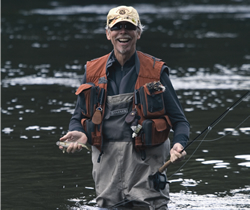 Tucked away, in this comparatively small island, are still places, mercifully, where footprints are few. Places where you can, just for a moment, rejoice in wild company and glimpse at a less populous past. Most of these are situated westerly: and a very unfair proportion can be found in the West Country: damn it! I say this, because I am a long way away and I can’t fish the huge variety of waters and diversity of species that this area has to offer, as much as I would like. I guess this makes the experience all the richer. I think too, that taking the West Country, as a whole is just a little misleading. Do we talk about the imperious coast-line and the wolf of the waves: bass? The more languid mullet or wrasse? Do we talk about the brutes of the channel wrecks and deep sea water?
Tucked away, in this comparatively small island, are still places, mercifully, where footprints are few. Places where you can, just for a moment, rejoice in wild company and glimpse at a less populous past. Most of these are situated westerly: and a very unfair proportion can be found in the West Country: damn it! I say this, because I am a long way away and I can’t fish the huge variety of waters and diversity of species that this area has to offer, as much as I would like. I guess this makes the experience all the richer. I think too, that taking the West Country, as a whole is just a little misleading. Do we talk about the imperious coast-line and the wolf of the waves: bass? The more languid mullet or wrasse? Do we talk about the brutes of the channel wrecks and deep sea water?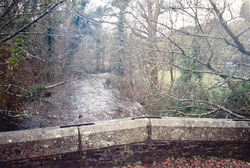 The River Fowey is a prime Cornish spate river giving excellent salmon and seatrout fishing. It is one of only two rivers in the south west of England holding its targets for sustainable salmonid stocks.
The River Fowey is a prime Cornish spate river giving excellent salmon and seatrout fishing. It is one of only two rivers in the south west of England holding its targets for sustainable salmonid stocks.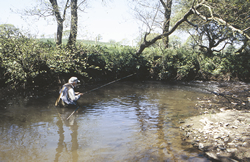 The margin between success and relative failure in fishing can be very small and this is particularly so in the case of the type of angling that I enjoy most – fly-fishing for trout on rivers. Indeed, there is an old saying that ten per cent of the fishermen catch ninety per cent of the fish and, although this sentiment may include a degree of exaggeration, it is probably pretty close to the truth. So, if you wish to join that small percentage of really successful fly fishers and clean up on the streams, what can you do to achieve success? Many anglers never get past the barrier of thinking that there is a single key to success and that a wonder fly rod or an irresistible fly will guarantee a constant flow of trout coming to the landing net. Fortunately there is no such “magic bullet” and if there were fishing would soon lose most of its fascination. Success, when it comes, is the result of getting lots of little things right, so here are a few tips to increase your strike rate with the trout on our rivers.
The margin between success and relative failure in fishing can be very small and this is particularly so in the case of the type of angling that I enjoy most – fly-fishing for trout on rivers. Indeed, there is an old saying that ten per cent of the fishermen catch ninety per cent of the fish and, although this sentiment may include a degree of exaggeration, it is probably pretty close to the truth. So, if you wish to join that small percentage of really successful fly fishers and clean up on the streams, what can you do to achieve success? Many anglers never get past the barrier of thinking that there is a single key to success and that a wonder fly rod or an irresistible fly will guarantee a constant flow of trout coming to the landing net. Fortunately there is no such “magic bullet” and if there were fishing would soon lose most of its fascination. Success, when it comes, is the result of getting lots of little things right, so here are a few tips to increase your strike rate with the trout on our rivers. There is something a bit special about tiny streams, especially for the wild trout fisherman. Our native wild brown trout is ideally suited to thrive on the smallest rivers and fortunately the south west has more than its share of these exciting waters, whether high on Dartmoor, Exmoor or Bodmin Moor, among the meadows of the rolling country of mid Devon or on the silky little chalk streams of Wessex.
There is something a bit special about tiny streams, especially for the wild trout fisherman. Our native wild brown trout is ideally suited to thrive on the smallest rivers and fortunately the south west has more than its share of these exciting waters, whether high on Dartmoor, Exmoor or Bodmin Moor, among the meadows of the rolling country of mid Devon or on the silky little chalk streams of Wessex.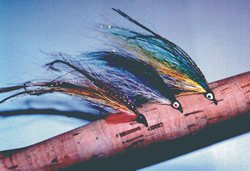
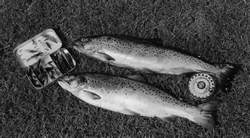 The Editor has requested that I do an article on Sea Trout fishing in Devon hence the title. It would be easy for me just to write a few paragraphs on my own experiences of fishing the Teign, Taw, Torridge, Mole or Dart and leave the reader with the feeling of ‘oh what a lucky bugger he is doing this for a living’, but you will be pleased, I hope, to read that’s not what this article is about.
The Editor has requested that I do an article on Sea Trout fishing in Devon hence the title. It would be easy for me just to write a few paragraphs on my own experiences of fishing the Teign, Taw, Torridge, Mole or Dart and leave the reader with the feeling of ‘oh what a lucky bugger he is doing this for a living’, but you will be pleased, I hope, to read that’s not what this article is about.